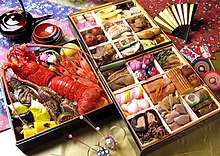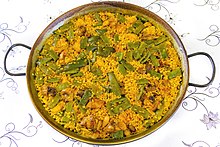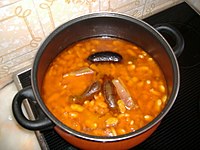Portal:Food
F o o d
A portal dedicated to food and foodways
Introduction


Food is any substance consumed by an organism for nutritional support. Food is usually of plant, animal, or fungal origin and contains essential nutrients such as carbohydrates, fats, proteins, vitamins, or minerals. The substance is ingested by an organism and assimilated by the organism's cells to provide energy, maintain life, or stimulate growth. Different species of animals have different feeding behaviours that satisfy the needs of their metabolisms and have evolved to fill a specific ecological niche within specific geographical contexts.
Omnivorous humans are highly adaptable and have adapted to obtain food in many different ecosystems. Humans generally use cooking to prepare food for consumption. The majority of the food energy required is supplied by the industrial food industry, which produces food through intensive agriculture and distributes it through complex food processing and food distribution systems. This system of conventional agriculture relies heavily on fossil fuels, which means that the food and agricultural systems are one of the major contributors to climate change, accounting for as much as 37% of total greenhouse gas emissions. (Full article...)
Cooking, also known as cookery or professionally as the culinary arts, is the art, science and craft of using heat to make food more palatable, digestible, nutritious, or safe. Cooking techniques and ingredients vary widely, from grilling food over an open fire, to using electric stoves, to baking in various types of ovens, reflecting local conditions. Cooking is an aspect of all human societies and a cultural universal.
Preparing food with heat or fire is an activity unique to humans. Archeological evidence of cooking fires from at least 300,000 years ago exists, but some estimate that humans started cooking up to 2 million years ago.
The expansion of agriculture, commerce, trade, and transportation between civilizations in different regions offered cooks many new ingredients. New inventions and technologies, such as the invention of pottery for holding and boiling of water, expanded cooking techniques. Some modern cooks apply advanced scientific techniques to food preparation to further enhance the flavor of the dish served. (Full article...)
Falafel (/fəˈlɑːfəl/; Arabic: فلافل, [fæˈlæːfɪl] ) is a deep-fried ball or patty-shaped fritter of Egyptian origin, featuring in Middle Eastern cuisine, particularly Levantine cuisines, and is made from broad beans, ground chickpeas, or both.
Falafel is often served in a pita, samoon, laffa, or wrapped in a flatbread known as taboon; "falafel" also frequently refers to a wrapped sandwich that is prepared in this way. The falafel balls may be topped with salads, pickled vegetables, and hot sauce, and drizzled with tahini-based sauces. Falafel balls may also be eaten alone as a snack or served as part of a meze tray (assortment of appetizers). (Full article...)
Selected article –
A pretzel (listen), from German pronunciation, standard German: Breze(l) (listen) is a type of baked pastry made from dough that is commonly shaped into a knot. The traditional pretzel shape is a distinctive symmetrical form, with the ends of a long strip of dough intertwined and then twisted back onto itself in a particular way (a pretzel loop or pretzel bow). Today, pretzels come in various shapes, textures, and colors, but the original soft pretzel is still one of the most common pretzel types to date.
Salt is the most common seasoning, or topping, for pretzels, complementing the washing soda or lye treatment that gives pretzels their traditional skin and flavor acquired through the Maillard reaction. Other toppings are mustard, cheeses, sugar, chocolate, cinnamon, sweet glazing, seeds, and nuts. Varieties of pretzels include soft pretzels, which should be eaten shortly after preparation, and hard-baked pretzels, which have a long shelf life. (Full article...)Selected cuisine -

Japanese cuisine encompasses the regional and traditional foods of Japan, which have developed through centuries of political, economic, and social changes. The traditional cuisine of Japan (Japanese: washoku) is based on rice with miso soup and other dishes with an emphasis on seasonal ingredients. Side dishes often consist of fish, pickled vegetables, and vegetables cooked in broth. Common seafood is often grilled, but it is also sometimes served raw as sashimi or as sushi. Seafood and vegetables are also deep-fried in a light batter, as tempura. Apart from rice, a staple includes noodles, such as soba and udon. Japan also has many simmered dishes, such as fish products in broth called oden, or beef in sukiyaki and nikujaga.
Historically influenced by Chinese cuisine, Japanese cuisine has also opened up to influence from Western cuisines in the modern era. Dishes inspired by foreign food—in particular Chinese food—like ramen and gyōza, as well as foods like spaghetti, curry and hamburgers, have been adapted to Japanese tastes and ingredients. Traditionally, the Japanese shunned meat as a result of adherence to Buddhism, but with the modernization of Japan in the 1880s, meat-based dishes such as tonkatsu and yakiniku have become common. Since this time, Japanese cuisine, particularly sushi and ramen, has become popular globally. (Full article...)Selected ingredient –

Brown sugar is a sucrose sugar product with a distinctive brown color due to the presence of molasses. It is by tradition an unrefined or partially refined soft sugar consisting of sugar crystals with some residual molasses content (natural brown sugar), but is now often produced by the addition of molasses to refined white sugar (commercial brown sugar). (Full article...)
Selected recipe –
Paella (/paɪˈɛlə/, /pɑːˈeɪjə/, py-EL-ə, pah-AY-yə, Valencian: [paˈeʎa]; Spanish: [paˈeʝa]) is a rice dish originally from the Valencian Community. Paella is regarded as one of the community's identifying symbols. It is one of the best-known dishes in Spanish cuisine.
The dish takes its name from the wide, shallow traditional pan used to cook the dish on an open fire, paella being the word for a frying pan in Valencian language. As a dish, it may have ancient roots, but in its modern form, it is traced back to the mid-19th century, in the rural area around the Albufera lagoon adjacent to the city of Valencia, on the Mediterranean coast of Spain. (Full article...)
Maria Eliza Rundell (née Ketelby; 1745 – 16 December 1828) was an English writer. Little is known about most of her life, but in 1805, when she was over 60, she sent an unedited collection of recipes and household advice to John Murray, of whose family—owners of the John Murray publishing house—she was a friend. She asked for, and expected, no payment or royalties.
Murray published the work, A New System of Domestic Cookery, in November 1805. It was a huge success and several editions followed; the book sold around half a million copies in Rundell's lifetime. The book was aimed at middle-class housewives. In addition to dealing with food preparation, it offers advice on medical remedies and how to set up a home brewery and includes a section entitled "Directions to Servants". The book contains an early recipe for tomato sauce—possibly the first—and the first recipe in print for Scotch eggs. Rundell also advises readers on being economical with their food and avoiding waste. (Full article...)Selected image –

Selected biography –
B. 27 May 1975
Jamie Trevor Oliver MBE OSI (born 27 May 1975) is an English celebrity chef, former restaurateur and cookbook author. He is known for his casual approach to cuisine, which has led him to front numerous television shows and open many restaurants.
Oliver reached the public eye when his series The Naked Chef premiered in 1999. In 2005, he opened a campaign, Feed Me Better, to introduce schoolchildren to healthier foods, which was later backed by the government. He was the owner of a restaurant chain, Jamie Oliver Restaurant Group, which opened its first restaurant, Jamie's Italian, in Oxford in 2008. The chain went into administration in May 2019. (Full article...)
Did you know (auto-generated) –

- ... that in November 2022, Leicester City Council used the Food Act 1984 in combination with a royal charter of 1199 to levy a charge on the organisers of two Christmas light switching-on events?
- ... that agronomist Simon Groot was awarded the 2019 World Food Prize for "benefiting hundreds of millions of consumers with greater access to nutritious vegetables"?
- ... that strawberry pie is one of the "red foods" traditionally served at Juneteenth celebrations?
- ... that British architect Diane Haigh transformed one historic building into an art gallery and another into a hospice?
- ... that food stylist Susan Spungen estimated that she baked hundreds of pies with Josh Brolin and film staff while practicing for a scene in Labor Day?
- ... that Tad's Steaks offered "tasty food, low prices, service with a grunt"?
More did you know –
Related portals
Food topics
The following are topics relating to food
Categories
Food list articles
- See also: Lists of foods and Category:Lists of drinks
The following are some Food list articles on Wikipedia:

- American cheeses
- Appellation d'Origine Contrôlée cheeses
- Apple cultivars
- Bacon dishes
- Bacon substitutes
- Basil cultivars
- Breads
- Breakfast beverages
- Breakfast cereals
- Breakfast foods
- British cheeses
- Cakes
- Candies
- Cheeses
- Cheese soups
- Christmas dishes (list)
- Cocktails
- Cookies
- Dishes using coconut milk
- Diets
- Doughnut varieties
- Egg dishes
- Fermented soy products
- Food additives
- Food additives (Codex Alimentarius)
- Foods named after people
- French cheeses
- French dishes
- Fried dough foods
- Fruits
- List of hamburgers
- Herbs and spices
- Hors d'oeuvre
- Indian dishes
- Indian snack foods
- Indonesian dishes
- Italian dishes
- Japanese snacks
- Japanese dishes
- Jewish dishes
- Kebabs
- Korean beverages
- Mango cultivars
- Moroccan dishes
- Pasta
- Pastries
- Philippine snack food
- Pies, tarts and flans
- Poppy seed pastries and dishes
- Potato dishes
- Puddings
- Raw fish dishes
- Rice dishes
- Rolled foods
- Sauces
- Seafood
- Seeds
- Sandwiches
- Snack foods
- Soft drinks by country
- Soul foods and dishes
- Soups
- Stews
- Street foods
- Tapas
- Turkish dishes
- Twice-baked foods
- Vegetable oils
- Vegetables
- Vodkas
Things you can do
Related WikiProjects
| Parent project: WikiProject Food and Drink | |
| Child projects: | Task forces: (All inactive) |
|
|
| Related projects: | |
New articles
Rules | Match log | Results page (for watching) | Last updated: 2024-06-09 19:27 (UTC)
Note: The list display can now be customized by each user. See List display personalization for details.
- Tākultu (edit | talk | history | links | watch | logs | tools) by HaniwaEnthusiast (talk · contribs · new pages (1)) started on 2024-06-09, score: 20
- Grilled honeycomb (edit | talk | history | links | watch | logs | tools) by Willuconquer (talk · contribs · new pages (4)) started on 2024-06-09, score: 10
- Argo (bar) (edit | talk | history | links | watch | logs | tools) by Another Believer (talk · contribs · new pages (57)) started on 2024-06-09, score: 10
- Coa (bar) (edit | talk | history | links | watch | logs | tools) by Another Believer (talk · contribs · new pages (57)) started on 2024-06-09, score: 10
- Licorería Limantour (edit | talk | history | links | watch | logs | tools) by Another Believer (talk · contribs · new pages (57)) started on 2024-06-09, score: 10
- Katana Kitten (edit | talk | history | links | watch | logs | tools) by Another Believer (talk · contribs · new pages (57)) started on 2024-06-09, score: 10
- Jigger & Pony (edit | talk | history | links | watch | logs | tools) by Another Believer (talk · contribs · new pages (57)) started on 2024-06-09, score: 10
- Handshake Speakeasy (edit | talk | history | links | watch | logs | tools) by Another Believer (talk · contribs · new pages (57)) started on 2024-06-08, score: 10
- Ha' (restaurant) (edit | talk | history | links | watch | logs | tools) by Another Believer (talk · contribs · new pages (57)) started on 2024-06-08, score: 10
- Cambodian Chinese cuisine (edit | talk | history | links | watch | logs | tools) by Turaids (talk · contribs · new pages (4)) started on 2024-06-08, score: 10
- Los Danzantes (edit | talk | history | links | watch | logs | tools) by Another Believer (talk · contribs · new pages (57)) started on 2024-06-08, score: 10
- Lort cha (edit | talk | history | links | watch | logs | tools) by Turaids (talk · contribs · new pages (4)) started on 2024-06-08, score: 10
- Tatsuki Mizuno (edit | talk | history | links | watch | logs | tools) by TSUBAME98 (talk · contribs · new pages (4)) started on 2024-06-08, score: 10
- Akihiro Wakabayashi (edit | talk | history | links | watch | logs | tools) by TSUBAME98 (talk · contribs · new pages (4)) started on 2024-06-08, score: 10
- Shun Mizutani (edit | talk | history | links | watch | logs | tools) by TSUBAME98 (talk · contribs · new pages (4)) started on 2024-06-08, score: 10
- Yua Tamiya (edit | talk | history | links | watch | logs | tools) by TSUBAME98 (talk · contribs · new pages (4)) started on 2024-06-08, score: 10
- Los Danzantes Oaxaca (edit | talk | history | links | watch | logs | tools) by Another Believer (talk · contribs · new pages (57)) started on 2024-06-08, score: 10
- Oryza coarctata (edit | talk | history | links | watch | logs | tools) by Peter coxhead (talk · contribs · new pages (12)) started on 2024-06-08, score: 20
- 2024 Korean Curling Championships (edit | talk | history | links | watch | logs | tools) by TracyFleuryFan (talk · contribs · new pages (5)) started on 2024-06-08, score: 10
- Michael Jordan's Steak House (edit | talk | history | links | watch | logs | tools) by Expandinglight5 (talk · contribs · new pages (1)) started on 2024-06-07, score: 30
- High Noon (seltzer) (edit | talk | history | links | watch | logs | tools) by BanjoZebra (talk · contribs · new pages (8)) started on 2024-05-25, score: 20
- Feeding America (edit | talk | history | links | watch | logs | tools) by Hey man im josh (talk · contribs · new pages (203)) started on 2024-06-07, score: 10
- Makohin (edit | talk | history | links | watch | logs | tools) by Altenmann (talk · contribs · new pages (161)) started on 2024-06-07, score: 10
- Chicken Bones (edit | talk | history | links | watch | logs | tools) by B3251 (talk · contribs · new pages (13)) started on 2024-06-07, score: 30
- Sissy Bar (Portland, Oregon) (edit | talk | history | links | watch | logs | tools) by Another Believer (talk · contribs · new pages (57)) started on 2024-06-06, score: 10
- Wunderbar (bar) (edit | talk | history | links | watch | logs | tools) by Brianda (Wiki Ed) (talk · contribs · new pages (4)) started on 2024-06-06, score: 10
- Sammy Haynes (edit | talk | history | links | watch | logs | tools) by Penale52 (talk · contribs · new pages (6)) started on 2024-06-06, score: 10
- Pachira insignis (edit | talk | history | links | watch | logs | tools) by BlakeALee (talk · contribs · new pages (1)) started on 2024-06-06, score: 10
- Biggio's (edit | talk | history | links | watch | logs | tools) by Another Believer (talk · contribs · new pages (57)) started on 2024-06-05, score: 10
- Scallion bread (edit | talk | history | links | watch | logs | tools) by Heeheemalu (talk · contribs · new pages (13)) started on 2024-06-05, score: 30
- Song Jae-jeong (edit | talk | history | links | watch | logs | tools) by Preferwiki (talk · contribs · new pages (3)) started on 2024-06-05, score: 10
- Beryl Shereshewsky (edit | talk | history | links | watch | logs | tools) by Samsmachado (talk · contribs · new pages (5)) started on 2024-06-04, score: 10
- Off the Griddle (edit | talk | history | links | watch | logs | tools) by Another Believer (talk · contribs · new pages (57)) started on 2024-06-04, score: 10
- The Captive of the Sahara (edit | talk | history | links | watch | logs | tools) by Lord Cornwallis (talk · contribs · new pages (60)) started on 2024-06-04, score: 10
- Apple bread (edit | talk | history | links | watch | logs | tools) by Heeheemalu (talk · contribs · new pages (13)) started on 2024-06-04, score: 20
- Chiang Yu-An (edit | talk | history | links | watch | logs | tools) by BemrXDD (talk · contribs · new pages (3)) started on 2024-06-03, score: 10
- John Greene (Nurse) (edit | talk | history | links | watch | logs | tools) by Sue8183 (talk · contribs · new pages (0)) started on 2024-06-03, score: 40
- Red Boat (edit | talk | history | links | watch | logs | tools) by Valereee (talk · contribs · new pages (5)) started on 2024-06-02, score: 10
- Agrosuper (edit | talk | history | links | watch | logs | tools) by FrederickEvans (talk · contribs · new pages (24)) started on 2024-06-02, score: 30
- Fowler Ltd. (edit | talk | history | links | watch | logs | tools) by EssNS (talk · contribs · new pages (26)) started on 2024-06-01, score: 10
- Nilla Wafers (edit | talk | history | links | watch | logs | tools) by Voorts (talk · contribs · new pages (41)) started on 2024-05-26, score: 10
- Solari's (edit | talk | history | links | watch | logs | tools) by Nolabob (talk · contribs · new pages (1)) started on 2024-06-01, score: 20
- Nasi katok (edit | talk | history | links | watch | logs | tools) by The Bangsawan (talk · contribs · new pages (29)) started on 2024-06-01, score: 20
- Justin Sterner (edit | talk | history | links | watch | logs | tools) by Muboshgu (talk · contribs · new pages (13)) started on 2024-05-31, score: 10
- Warankasi (edit | talk | history | links | watch | logs | tools) by Wiisstlo (talk · contribs · new pages (5)) started on 2024-05-26, score: 20
- Brennans Bread (edit | talk | history | links | watch | logs | tools) by Gatepainter (talk · contribs · new pages (3)) started on 2024-05-31, score: 20
- Karin-Lis Svarre (edit | talk | history | links | watch | logs | tools) by Ipigott (talk · contribs · new pages (7)) started on 2024-05-31, score: 10
- Indori poha (edit | talk | history | links | watch | logs | tools) by Apocheir (talk · contribs · new pages (4)) started on 2024-05-30, score: 20
- Tanuki (restaurant) (edit | talk | history | links | watch | logs | tools) by Another Believer (talk · contribs · new pages (57)) started on 2024-05-30, score: 10
- Ko Myeong-seok (edit | talk | history | links | watch | logs | tools) by Explicit (talk · contribs · new pages (7)) started on 2024-05-30, score: 10
- Savanyúság (edit | talk | history | links | watch | logs | tools) by Konnor Martin (talk · contribs · new pages (2)) started on 2024-05-29, score: 10
- Laal maas (edit | talk | history | links | watch | logs | tools) by SafariScribe (talk · contribs · new pages (231)) started on 2024-05-29, score: 30
- Furrundu (edit | talk | history | links | watch | logs | tools) by BaduFerreira (talk · contribs · new pages (3)) started on 2024-05-29, score: 50
- Hyman's Seafood (edit | talk | history | links | watch | logs | tools) by DMVHistorian (talk · contribs · new pages (4)) started on 2024-05-28, score: 10
- Pickup Coffee (edit | talk | history | links | watch | logs | tools) by Hariboneagle927 (talk · contribs · new pages (25)) started on 2024-05-28, score: 20
- Geoffrey Hawtin (edit | talk | history | links | watch | logs | tools) by Chromista (talk · contribs · new pages (1)) started on 2024-05-28, score: 10
- Palani Panchamirtham (edit | talk | history | links | watch | logs | tools) by Magentic Manifestations (talk · contribs · new pages (14)) started on 2024-05-27, score: 10
- Erismatopterus (edit | talk | history | links | watch | logs | tools) by Kevmin (talk · contribs · new pages (16)) started on 2024-05-27, score: 10
- Saskatoon berry pie (edit | talk | history | links | watch | logs | tools) by Reywas92 (talk · contribs · new pages (4)) started on 2024-05-27, score: 30
- Zus Coffee (edit | talk | history | links | watch | logs | tools) by Hariboneagle927 (talk · contribs · new pages (25)) started on 2024-05-27, score: 20
- Space Cola Wars (edit | talk | history | links | watch | logs | tools) by Artem.G (talk · contribs · new pages (20)) started on 2024-05-27, score: 10
- Conchas de Piedra (edit | talk | history | links | watch | logs | tools) by Another Believer (talk · contribs · new pages (57)) started on 2024-05-27, score: 10
Associated Wikimedia
The following Wikimedia Foundation sister projects provide more on this subject:
-
Commons
Free media repository -
Wikibooks
Free textbooks and manuals -
Wikidata
Free knowledge base -
Wikinews
Free-content news -
Wikiquote
Collection of quotations -
Wikisource
Free-content library -
Wikiversity
Free learning tools -
Wiktionary
Dictionary and thesaurus

















































